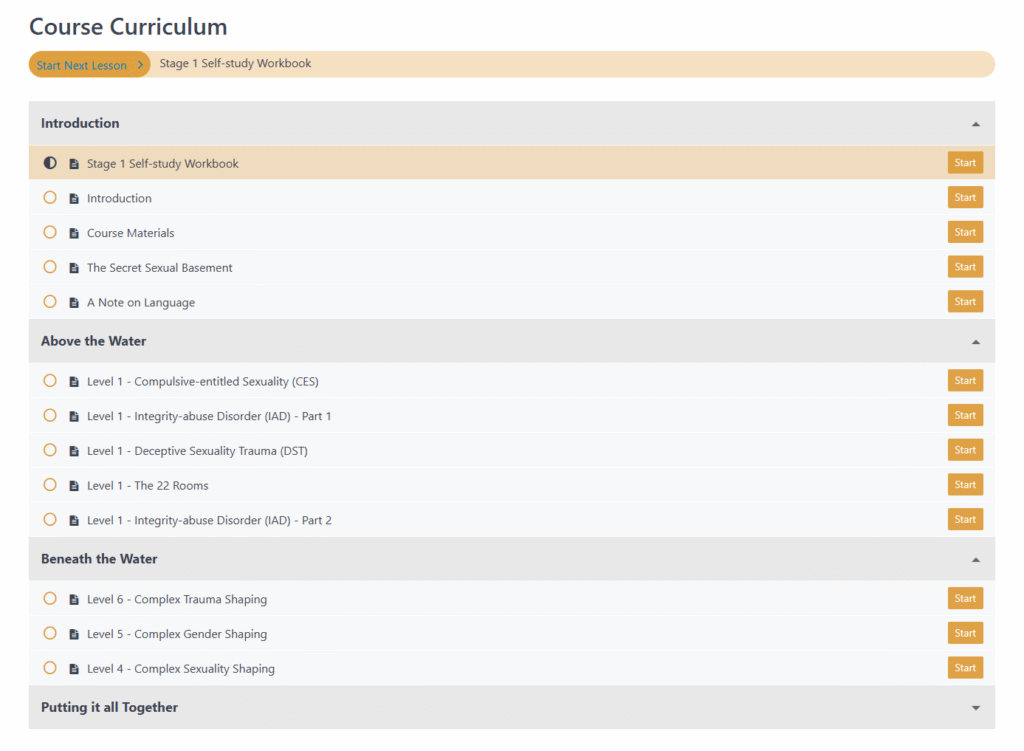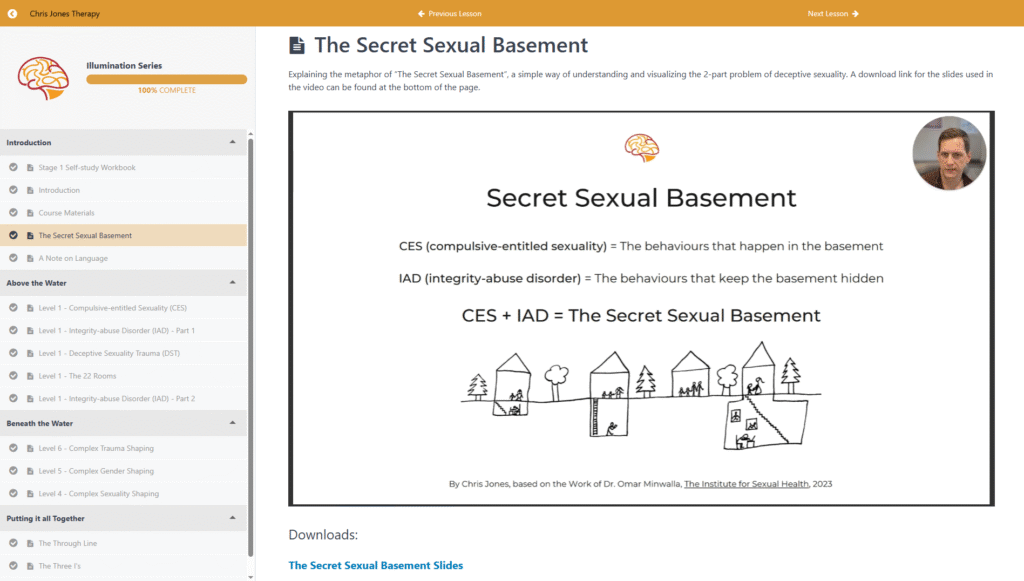
From Harm to Healing Course
The foundation of the From Harm to Healing treatment program is the extensive online course offered by Chris Jones Therapy, which provides in-depth psycho-education of the DST model as well as the clinical tools required to develop a thorough and effective treatment plan.
The course contains over 50 video lessons plus a workbook that guides you through the program and the various tasks that need to be completed. This approach provides ongoing structure to both individual and group sessions.
Course Structure
The course is broken down into the following 3 series, with each being covered in Stage 1 of the From Harm to Healing program:
Illumination Series – A psycho-educational series that explains the DST model and breaks down each part in detail.
Application Series – A practical series that takes you through all of the tools required to build a structured DST treatment plan.
Attending Series – An guide to “attending work”, which means learning how to attend in a healthy way to your partner whilst growing in your ability to deal with the post-traumatic reality of the relationship.

Course Contents
The layout of the course depends on the path chosen (group or individual) but the material is the same for both. Here’s a brief outline of the 16-week group version of the course to give you a clearer idea of what’s contained within the program.
Illumination Series
Week 1 – The Secret Sexual Basement
Introducing the course workbook and understanding our central metaphors – the secret sexual basement and the DST iceberg.
Week 2 – Above the Water
We start “above the water”, by defining and understanding the harmful behavioural systems that define deceptive sexuality – CES (compulsive-entitled sexuality) and IAD (integrity abuse disorder) – as well as exploring the traumatic impacts that are caused by the secret sexual basement.
Week 3 – Beneath the Water
We then move “underwater”, by defining and understanding the deeper parts of the iceberg – the trauma shaping, gender shaping, and sexuality shaping that may have contributed to the person’s development and maintenance of the secret sexual basement.
Week 4 – Putting it all Together
We finish the illumination series by putting it all together, understanding the “through line” from the underwater factors, to the behavioural systems above the surface.
Application Series
Week 5 – Foundations
We begin the application series by exploring restorative justice, and how the DST treatment approach differs from many traditional approaches. We also explore internal vs external motivation and defenses that might come up as we do this work.
Week 6 – Complex Gender and Sexuality Shaping
This is where we really start personalizing the work, exploring the stories of gender and sexuality shaping, and considering how this might still be impacting you in the present.
Week 7 – CES Assessments
We continue our assessment work in week 5, this time focussing on the CES (compulsive-entitled sexuality) – the behaviours that happened inside the basement.
Week 8 – IAD Assessments
We now move onto the IAD (integrity-abuse disorder) assessments – identifying the patterns of behaviour that kept the basement hidden, and continue to cause harm in the intimate relationship.
Week 9 – TARC Plan
Having done the assessment work, we can now start developing a TARC plan. You can think of this as a more detailed, targeted circle plan.
Week 10 – WTF Work
WTF stands for, “What am I think, and feeling”, and is a way of using CBT (cognitive behavioural therapy) to examine the drivers of the problematic behaviours (both CES and IAD).
Week 11 – Scans, Disclosure Agreements, and Accountability
We round out the application series by looking at how daily or weekly scans can be used to encourage ongoing engagement with the treatment plan, and how disclosure agreements and other accountability functions can be incorporated into the plan.
Attending Series
Attending: Week 12 – Post-betrayal Reality
We begin the attending series by delving deeper into the trauma responses we’ll often see from a betrayed partner and why we need to focus on attending to that trauma rather than trying to “fix” the person.
Attending: Week 13 – Developing Attending Skills
Once we’ve understood the importance of attending rather than fixing, we start to explore what this looks like in practice and how we can develop those skills over time.
Attending: Week 14 – Intentional Authentic Reality
We continue the attending work by looking at the importance of moving towards authentic expression – using the human voice to express accurate, authentic reality, rather than manipulated or deceptive reality.
Attending: Week 15 – Post-betrayal Cycle
As we approach the end of the program, we look at a model that helps us understand how we might be contributing to ongoing negative cycles that occur in the intimate relationship, and how we can apply the lessons we’ve learnt so far to start changing things.
Attending: Week 16 – Endings
In the final week of the program, we review what we’ve gone through in the course, and what the next steps might be in order to continue the work.

Lessons
Each individual lesson within the course includes a video presentation where a topic is explained in depth alongside illustrated slides to help you follow along. All of the slides and any other resources that are referenced are then available for download.
Your progress through the lessons is tracked within the course and each participant is provided with a workbook to help them track the homework that must be completed.